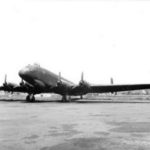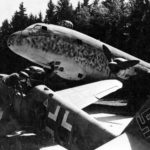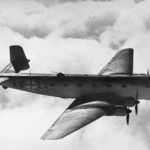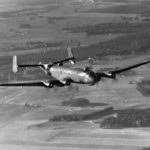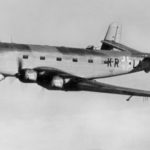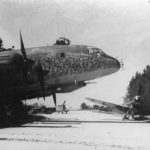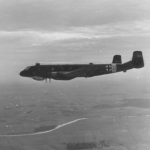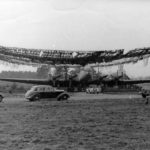Ju 290 A-1 SB+QC
Captured Junkers Ju 290A-4 (V7) 1945
Captured Ju 290 at Orly Paris 1945
Ju 290 A-4 W.Nr. 290110162 and Bf 109 Salzburg 1945
Ju 290A-5 KR+LA W.Nr. 290110170 in flight 1943/1944
Ju 290 A-2 9V+AH W.Nr. 158 Ex SB+QH of the 1/FAGr 5 in flight 1943
Ju 290A-5 KR+LA W.Nr. 0170 in flight 1943/1944
Captured Ju 290 A-4 9V+EK Salzburg 1945
Ju 290A-4 V7 0165 “Alles Kaputt” Orly, Paris 1945 2
Junkers Ju 290A-4 (V7) W Nr. 110196, “Alles Kaputt” Orly Paris 1945 2
Ju 290 A-3 9V+DK WNr.161 Ex PI+PO 2/FAGr 5 in flight 1943
Camouflaged Ju 290 A-5 9V+DH Ex KR+LA of the 1/FAGr 5 Mont de Marsan 1943
Ju 290 was a long-range transport, maritime patrol aircraft and bomber used by the Luftwaffe late in World War II. It was developed from earlier Junkers 90 design dating from before the war.
Design and Structure
- Wings: Low-wing cantilever monoplane design with a rectangular center-section and equally tapering outer sections. It features an all-metal structure, slotted flaps on the center-section, and slotted and divided ailerons on the outer sections.
- Fuselage: Rectangular-section all-duralumin construction with transverse bulkheads, frames, longitudinal stringers, and a smooth stressed skin.
- Tail Unit: Cantilever monoplane type with a slight dihedral tailplane and twin fins and rudders. The structure is made of duralumin with a stressed-skin covering.
- Landing Gear: Retractable type with twin wheels. The main gear retracts backward into the tails of the inboard engine nacelles using hydraulic retraction. The tail-wheel is fully retractable.
Power Plant
- Engines: Equipped with four 1,600 h.p. BMW 801 14-cylinder radial air-cooled engines mounted on the leading edge of the center-section. The aircraft has normal wing fuel tankage of 1,580 Imperial gallons, with a maximum tankage (including fuselage tanks) of 4,620 Imperial gallons.
Accommodation
- Crew: The crew’s position in the nose accommodates two side-by-side with dual controls. The radio-operator’s compartment follows, featuring a gun turret in the roof and a gun blister below. The main cabin can accommodate up to 40 fully-armed troops or varied freight loads, including wheeled vehicles. The maximum freight load is 22,000 lbs. (10,000 kg.). For freight loading, a heavy ramp is present, with wheel troughs and steps, hinged at the forward end and operated by jacks powered by a small auxiliary engine. The tail is jacked up to provide clearance when the ramp is lowered.
Armament
- Configuration: The armament varies according to the aircraft’s role. The transport version typically mounts:
- One MG 151/20 cannon in the dorsal turret
- One MG 151/20 in the tail
- Two twin MG 81 machine guns in the ventral blister, with one pair firing forward and the other aft.
The heavily-armed reconnaissance version may include:
- Two MG 151/20 cannons in the forward dorsal turret
- Two MG 151/20 cannons in the rear dorsal turret
- One MG 151/20 in the tail
- Additional MG 151/20 and MG 131 guns in various positions, including side and nose positions.
Dimensions and Weight
- Dimensions:
- Span: 138 ft. (42 m)
- Length: 92 ft. 6 in. (28.2 m)
- Wing area: 2,210 sq. ft. (205.3 sq. m)
- Weights:
- Loaded weight (transport): 88,000 lbs. (39,950 kg)
- Loaded weight (passenger and freight version): 90,500 lbs. (41,090 kg)
- Loaded weight (reconnaissance and anti-shipping version): 100,000 lbs. (45,400 kg)
Performance
- Maximum Speed: 280 mph (448 km/h) at 18,000 ft (5,490 m)
- Climb: 10 minutes to 6,500 ft (at a take-off weight of 99,000 lbs / 45,000 kg)
- Service Ceiling: 19,700 ft (6,010 m)
- Range:
- Maximum economical cruising speed with maximum fuel: 3,785 miles (6,060 km)
- Maximum economical cruising speed with 17,600 lbs (8,000 kg) freight: 2,490 miles (3,985 km)
